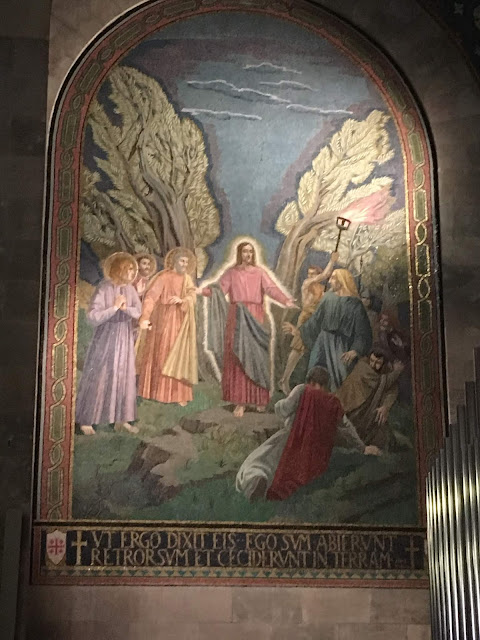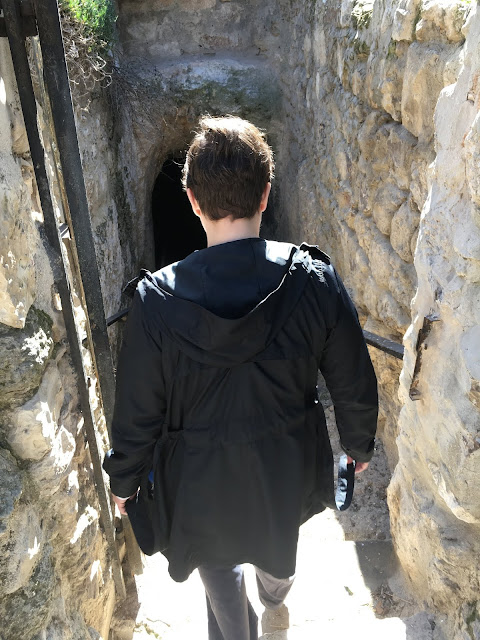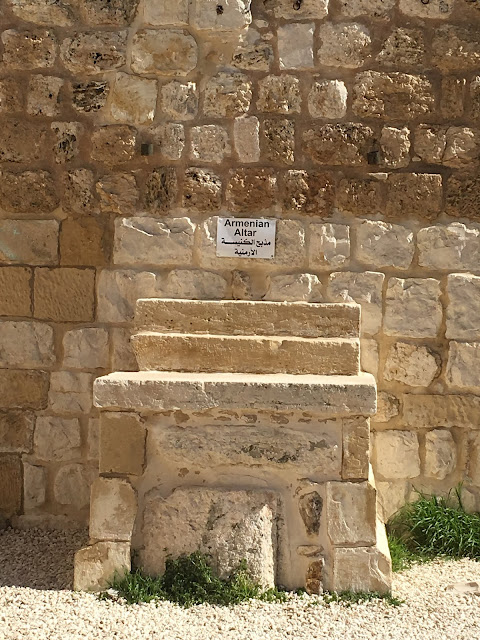This stone bench, encased in glass, is said to be the place where Mary's body was laid out after her death. I'm guessing the papers on it are requests and prayers of believers.
Just above the Tomb of Mary is a beautiful private garden where Christian pilgrim tour groups can arrange to visit and hold services. It claims to be where Jesus was praying when he was arrested before he was crucified.
However, on the other side of the road is a garden which is more traditionally considered the Garden of Gethsemane. Operated by the Franciscans, it is a garden of very old olive trees. Some claim the trees are from the time of Christ, which is unlikely, though olive trees' growth patterns make it a possibility that these are descendents of trees from that time.
Behind the garden is the Church of All Nations -- also called the Basilica of the Agony -- commemorating Jesus' struggle with what he foresaw in his future (See Luke 22: 41-44). Scripture says he was in such agony as he prayed that his sweat was like great drops of blood.
The stone in front of the altar in the church is, according to tradition, where Jesus prayed and agonized in Gethsemane.
The church houses the bones -- "holy relics of the righteous martyrs" -- of the Grand Duchess Elizabeth (wife of the brother to the Emperor Alexander III, and founder of the female monastic community named after the sisters Martha and Mary after her husband's assassination in 1905) and her faithful cell attendant nun, Barbara.
The views from this church site over the city of Jerusalem are beautiful, and the weather was perfect.
There were several handsome grey cats sunning themselves in the gardens around the church. They all looked well fed and quite comfortable with people.
The next site up the mount is The Jewish Cemetery, the most important cemetery to the Jewish community all over the world. The graves of numerous famous Jews, including Menachem Begin, are here.
A church built to memorialize Jesus weeping over Jerusalem and foreseeing its destruction comes next (See Luke 19: 37-42). It's said to be built in the shape of a teardrop, the corners of the dome are shaped like tear bottles, and it's called Dominus Flavit which in Latin means "the Lord wept."
The panoramic view of Jerusalem from this spot was a worthy backdrop for a picture of our group.
Almost at the top of the mount is a cave which claims to be the tomb of the prophets Haggai, Zachariah, and Malachi; however, archaeologists date the burial chambers to several centuries later than these prophets. Authentic or not, the tombs are interesting.
One enters by stairs into a shaft which leads to a large room with two concentric circular passages leading out around it with burial chambers branching out from them. The guide there said the burials had been also used by disciples of these three prophets as well as the prophets themselves.
The passages had almost no lighting except for the live candles each of us were given to use as we walked through.
Estonian
Old Norwegian
English
And finally, the Chapel of the Ascension, which is built over the spot where tradition says Jesus ascended into heaven. In the floor of the chapel is a stone which is said to show Jesus' footprint.
Previously, a larger Byzantine church commemorated the ascension on this spot. Now only the corner pillars remain.
Each year, 40 days after Easter, services are held under tents erected in the courtyard to remember the ascension of Christ into heaven. Each faith represented has its own altar.
In the same complex a mosque, The Mosque of the Ascension, has been erected to commemorate the Muslim belief that Jesus, a prophet, ascended into heaven from this spot.
An interesting and beautiful morning. I'll leave you with this photo from the Garden of Gethsame wishing you peace, salam, and shalom.















































thanks for the tour Asta, Turkey has lots of places with legends attached many Bible Characters but from Islam stories which we don't have in christian legends. Always fun.
ReplyDeleteVery interesting! Thank you for sharing!
ReplyDelete